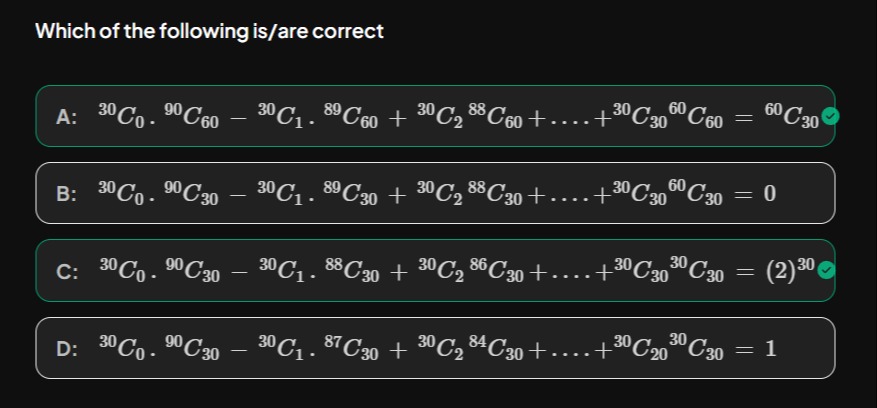Question
Question: Which of the following is/are correct...
Which of the following is/are correct

30C0⋅90C60−30C1⋅89C60+30C288C60+⋯+30C3060C60=60C30
30C0⋅90C30−30C1⋅89C30+30C288C30+⋯+30C3060C30=0
30C0⋅90C30−30C1⋅88C30+30C286C30+⋯+30C3030C30=(2)30
30C0⋅90C30−30C1⋅87C30+30C284C30+⋯+30C2030C30=1
A, C
Solution
The problem asks us to verify the correctness of four given combinatorial identities. We will analyze each option separately.
Option A:
The given identity is SA=∑r=030(−1)r30Cr90−rC60.
We can express 90−rC60 as the coefficient of x60 in the expansion of (1+x)90−r.
So, SA=∑r=030(−1)r30Cr[x60](1+x)90−r, where [xk]P(x) denotes the coefficient of xk in the polynomial P(x).
SA=[x60]∑r=030(−1)r30Cr(1+x)90−r
SA=[x60](1+x)90∑r=030(−1)r30Cr(1+x)−r
SA=[x60](1+x)90∑r=03030Cr(−1+x1)r
Using the binomial theorem ∑r=0nnCryr=(1+y)n, with n=30 and y=−1+x1, we get:
SA=[x60](1+x)90(1−1+x1)30
SA=[x60](1+x)90(1+x1+x−1)30
SA=[x60](1+x)90(1+xx)30
SA=[x60](1+x)90(1+x)30x30
SA=[x60]x30(1+x)60
SA=[x30](1+x)60
The coefficient of x30 in (1+x)60 is 60C30.
So, the left side of identity A is 60C30. The right side is also 60C30.
Thus, option A is correct.
Option B:
The given identity is SB=∑r=030(−1)r30Cr90−rC30.
We can express 90−rC30 as the coefficient of x30 in the expansion of (1+x)90−r.
So, SB=∑r=030(−1)r30Cr[x30](1+x)90−r.
SB=[x30]∑r=030(−1)r30Cr(1+x)90−r
SB=[x30](1+x)90∑r=030(−1)r30Cr(1+x)−r
SB=[x30](1+x)90(1−1+x1)30
SB=[x30](1+x)90(1+xx)30
SB=[x30]x30(1+x)60
SB=[x0](1+x)60
The coefficient of x0 in (1+x)60 is 60C0=1.
So, the left side of identity B is 1. The right side is 0.
Thus, option B is incorrect.
Option C:
The given identity is SC=30C0⋅90C30−30C1⋅88C30+30C286C30−⋯+30C3030C30.
The general term of the sum is (−1)r30Cr90−2rC30 for r=0,1,…,30.
So, SC=∑r=030(−1)r30Cr90−2rC30.
We express 90−2rC30 as the coefficient of x30 in (1+x)90−2r.
SC=∑r=030(−1)r30Cr[x30](1+x)90−2r
SC=[x30]∑r=030(−1)r30Cr(1+x)90−2r
SC=[x30](1+x)90∑r=030(−1)r30Cr(1+x)−2r
SC=[x30](1+x)90∑r=03030Cr(−(1+x)21)r
SC=[x30](1+x)90(1−(1+x)21)30
SC=[x30](1+x)90((1+x)2(1+x)2−1)30
SC=[x30](1+x)90((1+x)21+2x+x2−1)30
SC=[x30](1+x)90((1+x)22x+x2)30
SC=[x30](1+x)90((1+x)2x(2+x))30
SC=[x30](1+x)90(1+x)60x30(2+x)30
SC=[x30]x30(1+x)30(2+x)30
SC=[x0](1+x)30(2+x)30
SC=[x0]((1+x)(2+x))30
SC=[x0](2+3x+x2)30
The constant term (coefficient of x0) is obtained by setting x=0 in the polynomial 2+3x+x2.
So, SC=(2+3⋅0+02)30=230.
The left side of identity C is 230. The right side is (2)30.
Thus, option C is correct.
Option D:
The given identity is SD=30C0⋅90C30−30C1⋅87C30+30C284C30−⋯+30C2030C30.
The general term of the sum is (−1)r30Cr90−3rC30 for r=0,1,…,20.
The last term is for r=20: (−1)2030C2090−3⋅20C30=30C2090−60C30=30C2030C30. This matches the last term in the sum.
So, SD=∑r=020(−1)r30Cr90−3rC30.
We express 90−3rC30 as the coefficient of x30 in (1+x)90−3r.
SD=∑r=020(−1)r30Cr[x30](1+x)90−3r.
The sum goes up to r=20, not 30. However, for r>20, 90−3rC30=0 because 90−3r<30 for r>20. For example, if r=21, 90−3(21)=90−63=27<30. So 27C30=0.
Thus, we can extend the sum up to r=30 without changing the value.
SD=∑r=030(−1)r30Cr90−3rC30.
SD=[x30]∑r=030(−1)r30Cr(1+x)90−3r
SD=[x30](1+x)90∑r=030(−1)r30Cr(1+x)−3r
SD=[x30](1+x)90∑r=03030Cr(−(1+x)31)r
SD=[x30](1+x)90(1−(1+x)31)30
SD=[x30](1+x)90((1+x)3(1+x)3−1)30
SD=[x30](1+x)90((1+x)31+3x+3x2+x3−1)30
SD=[x30](1+x)90((1+x)33x+3x2+x3)30
SD=[x30](1+x)90((1+x)3x(3+3x+x2))30
SD=[x30](1+x)90(1+x)90x30(3+3x+x2)30
SD=[x30]x30(3+3x+x2)30
SD=[x0](3+3x+x2)30
The constant term (coefficient of x0) is obtained by setting x=0 in the polynomial 3+3x+x2.
So, SD=(3+3⋅0+02)30=330.
The left side of identity D is 330. The right side is 1.
Thus, option D is incorrect.
The correct options are A and C.
